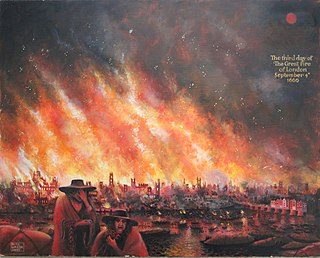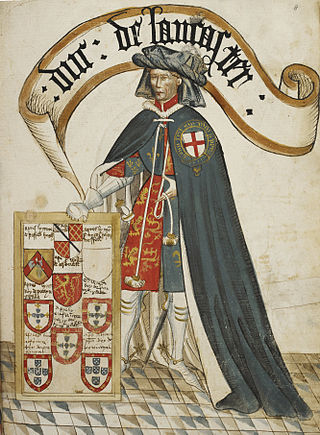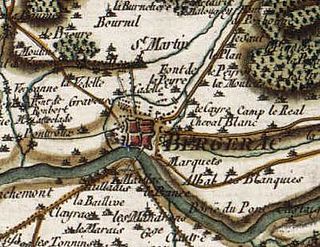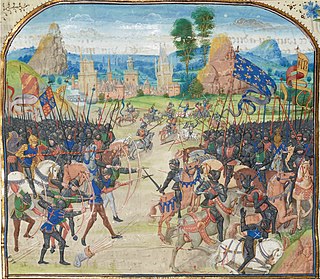Annus mirabilis (pl. anni mirabiles) is a Latin phrase that means "marvelous year", "wonderful year", "miraculous year", "year of wonder" or "amazing year". This term has been used to refer to several years during which events of major importance are remembered, notably Isaac Newton's discoveries in 1666 and Albert Einstein's papers published in 1905.
Eight years after the start of the Hundred Years' War, large-scale fighting had died down. Edward III of England decided to renew the war more vigorously in 1345. [1] He despatched a small force to Gascony in south-west France under Henry, Earl of Derby [2] and personally led the main English army to northern France. Edward delayed the disembarkation of his army and his fleet was scattered by a storm, rendering this offensive ineffective. [3] Derby was spectacularly successful, winning victories at Bergerac and Auberoche. [4] The following spring, a large French army, led by the heir to the French throne, John, Duke of Normandy, counter-attacked Derby's forces. [5]
Edward responded by landing an army of 10,000 men in northern Normandy. [6] The English devastated much of Normandy and stormed and sacked Caen, slaughtering the population. They cut a swath along the left bank of the Seine to within 20 miles (32 km) of Paris. [7] The English army then turned north and inflicted a heavy defeat on a French army led by their king, Philip VI, at the Battle of Crécy on 26 August 1346. [8] [9] They promptly exploited this by laying siege to Calais. [10] The period from Derby's victory outside Bergerac in late August 1345 to the start of the siege of Calais on 4 September 1346 became known as Edward III's annus mirabilis. [11] [12]
In January 1492, Isabella I and Ferdinand II, the Catholic Monarchs of Spain, completed the conquest of Granada, concluding the centuries-long Reconquista and bringing an end to Muslim rule over the Iberian Peninsula. Later that year, they would sponsor Christopher Columbus's first voyage across the Atlantic, resulting in the discovery of the Americas on October 12.
That same year, Antonio de Nebrija published his monumental grammar of Spanish, Gramática de la lengua castellana. It is notable as the first work to focus on the grammar of a modern Western European language, rather than Latin. [13]
In 1543, Nicolaus Copernicus published De revolutionibus orbium coelestium, outlining his heliocentric model of the universe. This event is traditionally held to be the beginning of the wider Scientific Revolution, which saw the emergence of modern science in Europe. [14] Andreas Vesalius also published his De humani corporis fabrica in 1543, revolutionizing the science of anatomy and the practice of medicine.[ citation needed ]
During the course of [1625] Breda surrendered to the Army of Flanders under the command of the incomparable Spinola; the republic of Genoa, Spain's ally and client, was rescued from the onslaught of the combined forces of France and Savoy; a joint Spanish-Portuguese naval expedition drove the Dutch from Bahia in Brazil; and an English expeditionary force was humiliatingly defeated when it attempted an attack on Cadiz.
-– Geoffrey Parker, The Thirty Years' War [15]
A series of Spanish military victories on a global strategic scale obtained in 1625 during the Thirty Years' War, in important military theaters in Europe and America. These military victories were as follows: Siege of Breda, Relief of Genoa, Recapture of Bahia, Battle of San Juan and Defense of Cádiz. [16] Those military actions were immortalized in a series of paintings in the Hall of Realms of the Buen Retiro Palace in Madrid. Thus, the “reputational” policy promoted by the Gaspar de Guzmán, Count-Duke of Olivares, favourite of Philip IV of Spain, was apparently confirmed by the initial success, [17] and it was in reference to this annus mirabilis for Spanish arms that Olivares delivered probably his most famous pronouncement: "God is Spanish and fights for Spain." [15]
The military successes of James Graham, 1st Marquess of Montrose in Scotland in the War of the Three Kingdoms during 1644–1645 are sometimes called "annus mirabilis". [18] [19]
In 1666, Isaac Newton, aged 23, made revolutionary inventions and discoveries in calculus, motion, optics and gravitation. It was in this year that Newton was alleged to have observed an apple falling from a tree, and in which he, in any case, hit upon the law of universal gravitation (Newton's apple). He was afforded the time to work on his theories due to the closure of Cambridge University by an outbreak of plague. [20] [21]
In 1706, the Grand Alliance arrayed against Louis XIV of France won resounding victories (the Battle of Ramillies and Siege of Turin) which, after the previous year's failures, has been termed by James Falkner a "Year of Miracles." [22]
A series of victories by the British armed forces in 1759 in North America, Europe, India, and in various naval engagements caused that year to be referred to, on occasion, as William Pitt's annus mirabilis. It was the turning point of the Seven Years' War. [23] [24]
It was in this year that Albert Einstein, aged 26, published important discoveries concerning the photoelectric effect, Brownian motion, the special theory of relativity, and the famous E = mc2 equation. His four articles, collectively known as his Annus Mirabilis papers, were published in Annalen der Physik in 1905. [25] [26]
1939 is considered the Annus Mirabilis of Hollywood due to the surprising number of movies released that year that are considered "classics" or foundational of their genre. [27] Some of the films released in 1939 include: The Wizard of Oz , Gone with the Wind , Gunga Din , Beau Geste , Union Pacific , The Roaring Twenties , Only Angels Have Wings , At the Circus , Stagecoach , Mr. Smith Goes to Washington , Ninotchka , Destry Rides Again , Midnight , Wuthering Heights , Young Mr. Lincoln , among many others.
Portugal is known for being "the country of the 3 Fs" because of Football, Fado, and Fátima, three of the most distinct parts of the Portuguese culture. [28] Portugal managed to clinch a series of historic and unprecedented victories in all of these three aspects in 2016—17. First in football, when the Portugal national team won their first-ever major trophy at the UEFA Euro 2016 on 10 July. Ten months later, on 13 May 2017, Salvador Sobral won the Eurovision Song Contest 2017 for Portugal with the song "Amar pelos dois", and in doing so, he gave Portugal its first-ever win in the contest. [29] On that same day, Pope Francis visited Fátima on the occasion of the 100th Anniversary of the Marian Apparition of 1917. [30] [31] The period from Portugal's victory at the Euros in July 2016 to the end of Pope Francis's visit to Portugal in May 2017 became known as Portugal's annus mirabilis. [32]
In the same year [1666] I began to think of gravity extending to the orb of the moon, .... All this was in the two plague years of 1665 and 1666, for in those days I was in the prime of my age for invention, and minded mathematics and philosophy more than at any time since.
In the beginning of the year 1665 I found the Method of approximating series & the Rule for reducing any dignity of any Binomial into such a series. The same year in May I found the method of Tangents of Gregory & Slusius, & in November had the direct method of fluxions & the next year in January had the Theory of Colors & in May following I had entrance into the inverse method of fluxions. And the same year I began to think of gravity extending to the orb of the Moon & (having found out how to estimate the force with which a globe revolving within a sphere presses the surface of the sphere) from Keplers rule of the periodical times of the Planets being in sesquialterate proportion of their distances from the centers of their Orbs, I deduced that the forces which keep the Planets in their Orbs must be reciprocally as the squares of their distances from the centers about which they revolve: and thereby compared the force requisite to keep the Moon in her Orb with the force of gravity at the surface of the earth ... All this was in the two plague years of 1665 and 1666. For in those days I was in the prime of my age of invention & minded Mathematics & Philosophy more than at any time since.
{{cite book}}: |journal= ignored (help)
1666 (MDCLXVI) was a common year starting on Friday of the Gregorian calendar and a common year starting on Monday of the Julian calendar, the 1666th year of the Common Era (CE) and Anno Domini (AD) designations, the 666th year of the 2nd millennium, the 66th year of the 17th century, and the 7th year of the 1660s decade. As of the start of 1666, the Gregorian calendar was 10 days ahead of the Julian calendar, which remained in localized use until 1923.

The Battle of Crécy took place on 26 August 1346 in northern France between a French army commanded by King Philip VI and an English army led by King Edward III. The French attacked the English while they were traversing northern France during the Hundred Years' War, resulting in an English victory and heavy loss of life among the French.

Henry of Grosmont, Duke of Lancaster was an English statesman, diplomat, soldier, and Christian writer. The owner of Bolingbroke Castle in Lincolnshire, Grosmont was a member of the House of Plantagenet, which was ruling over England at that time. He was the wealthiest and most powerful peer of the realm.

Annus Mirabilis is a poem written by John Dryden published in 1667. It commemorated 1665–1666, the "year of miracles" of London. Despite the poem's name, the year had been one of great tragedy, including the Great Fire of London. The title was perhaps meant to suggest that the events of the year could have been worse. Dryden wrote the poem while at Charlton in Wiltshire, where he went to escape one of the great events of the year: the Great Plague of London.

The siege of Calais occurred at the conclusion of the Crécy campaign, when an English army under the command of King Edward III of England successfully besieged the French town of Calais during the Edwardian phase of the Hundred Years' War.

The Battle of Blanchetaque was fought on 24 August 1346 between an English army under King Edward III and a French force commanded by Godemar du Fay. The battle was part of the Crécy campaign, which took place during the early stages of the Hundred Years' War. After landing in the Cotentin Peninsula on 12 July, the English army had burnt a path of destruction through some of the richest lands in France to within 20 miles (32 km) of Paris, sacking a number of towns on the way. The English then marched north, hoping to link up with an allied Flemish army which had invaded from Flanders. They were outmanoeuvred by the French king, Philip VI, who garrisoned all of the bridges and fords over the River Somme and followed the English with his own field army. The area had previously been stripped of food stocks by the French, and the English were essentially trapped.
The Battle of Auberoche was fought on 21 October 1345 during the Gascon campaign of 1345 between an Anglo-Gascon force of 1,200 men under Henry, Earl of Derby, and a French army of 7,000 commanded by Louis of Poitiers. It was fought at the village of Auberoche near Périgueux in northern Aquitaine. At the time, Gascony was a territory of the English Crown and the "English" army included a large proportion of native Gascons. The battle resulted in a heavy defeat for the French, who suffered very high casualties, with their leaders killed or captured.

The Battle of Caen was an assault conducted on 26 July 1346 by forces from the Kingdom of England, led by King Edward III, on the French-held town of Caen and Normandy as a part of the Hundred Years' War.

The Battle of Bergerac was fought between Anglo-Gascon and French forces at the town of Bergerac, Gascony, in August 1345 during the Hundred Years' War. In early 1345 Edward III of England decided to launch a major attack on the French from the north, while sending smaller forces to Brittany and Gascony, the latter being both economically important to the English war effort and the proximate cause of the war. The French focused on the threat to northern France, leaving comparatively small forces in the south-west.

The Gascon campaign of 1345 was conducted by Henry, Earl of Derby, as part of the Hundred Years' War. The whirlwind campaign took place between August and November 1345 in Gascony, an English-controlled territory in south-west France. Derby, commanding an Anglo-Gascon force, oversaw the first successful English land campaign of the war. He twice defeated large French armies in battle, taking many noble and knightly prisoners. They were ransomed by their captors, greatly enriching Derby and his soldiers in the process. Following this campaign, morale and prestige swung England's way in the border region between English-occupied Gascony and French-ruled territory, providing an influx of taxes and recruits for the English armies. As a result, France's ability to raise tax money and troops from the region was much reduced.
The Truce of Calais was a truce agreed by King Edward III of England and King Philip VI of France on 28 September 1347, which was mediated by emissaries of Pope Clement VI. The Hundred Years' War had broken out in 1337 and in 1346 Edward had landed with an army in northern France. After inflicting a heavy defeat on Philip and a French army at the Battle of Crécy the English besieged Calais, which fell after 11 months. Both countries were financially and militarily exhausted and two cardinals acting for Pope Clement were able to broker a truce in a series of negotiations outside Calais. This was signed on 28 September to run until 7 July 1348.

The siege of Aiguillon, an episode in the Hundred Years' War, began on 1 April 1346 when a French army commanded by John, Duke of Normandy, laid siege to the Gascon town of Aiguillon. The town was defended by an Anglo-Gascon army under Ralph, Earl of Stafford.

Lancaster's chevauchée of 1346 was a series of offensives directed by Henry, Earl of Lancaster, in southwestern France during autumn 1346, as a part of the Hundred Years' War.

The Crécy campaign was a series of large-scale raids (chevauchées) conducted by the Kingdom of England throughout northern France in 1346 that devastated the French countryside on a wide front, culminating in the Battle of Crécy. The campaign was part of the Hundred Years' War.

The Black Prince's chevauchée of 1356 was a large-scale mounted raid by an Anglo-Gascon force under the command of Edward, the Black Prince, between 4 August and 2 October 1356 as a part of the Hundred Years' War. The war had broken out in 1337, but a truce and the ravages of the Black Death had restricted the extent of the fighting since 1347. In 1355 the French king, John II, determined to resume full-scale war. That autumn, while Edward III of England threatened northern France, his son, Edward of Woodstock, later known as the Black Prince, carried out a devastating mounted raid, or chevauchée: an Anglo-Gascon army marched from the English possession of Gascony 675 miles (1,086 km) to Narbonne and back. The French refused battle, despite suffering enormous economic damage.

The Black Prince's chevauchée, also known as the grande chevauchée, was a large-scale mounted raid carried out by an Anglo-Gascon force under the command of Edward, the Black Prince, between 5 October and 2 December 1355 as a part of the Hundred Years' War. John, Count of Armagnac, who commanded the local French forces, avoided battle, and there was little fighting during the campaign.
Lancaster's chevauchée of 1356 in Normandy was an English offensive directed by Henry, Duke of Lancaster, in northern France during 1356, as a part of the Hundred Years' War. The offensive took the form of a large mounted raid – a chevauchée – and lasted from 22 June to 13 July. During its final week the English were pursued by a much larger French army under King John II that failed to force them to battle.
Lancaster's Loire campaign was the march south from Brittany in August 1356 by an English army led by Henry, Duke of Lancaster. He was attempting to join the army of Edward, the Black Prince, near Tours. The French had broken the bridges over the River Loire and Lancaster was forced to turn back, returning to Brittany in September.

The siege of Breteuil was the investment of the Norman town of Breteuil, held by partisans of Charles II, King of Navarre, by French forces. It lasted from April to about 20 August 1356. It was interrupted on 5 July when a small English army commanded by Henry, Earl of Lancaster relieved and resupplied it. The French king, John II, attempted to bring Lancaster to battle with the much larger French royal army, but Lancaster marched away and the attempt failed. John then renewed the siege of Breteuil.

English offensives in 1345–1347, during the Hundred Years' War, resulted in repeated defeats of the French, the loss or devastation of much French territory and the capture by the English of the port of Calais. The war had broken out in 1337 and flared up in 1340 when the king of England, Edward III, laid claim to the French crown and campaigned in northern France. There was then a lull in the major hostilities, although much small-scale fighting continued.